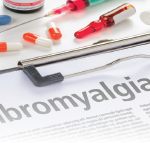 Fibromyalgia afflicts more than 2% of the U.S. population and causes chronic, widespread pain.1,2 However, diagnosing fibromyalgia has proved challenging, and the condition remains undiagnosed in three out of four people with it.3
Fibromyalgia afflicts more than 2% of the U.S. population and causes chronic, widespread pain.1,2 However, diagnosing fibromyalgia has proved challenging, and the condition remains undiagnosed in three out of four people with it.3
The diagnostic challenges associated with fibromyalgia are multi-factorial, owing to costly and difficult access to testing, such as functional magnetic resonance imaging to identify brain changes, as well as risk to the patient, such as collecting cerebral spinal fluid to identify elevations in neurotransmitters.
But hope may be on the horizon. Early findings from a study have identified a spectral signature that is unique to fibromyalgia and may offer an accessible testing methodology from a simple blood test, according to Kevin Hackshaw, MD, a rheumatologist at The Ohio State University Wexner Medical Center in Columbus, and the study’s lead investigator.4
The investigators evaluated components within blood cell membranes to identify a unique signature that differentiated individuals with fibromyalgia from those with several other rheumatic conditions, including rheumatoid arthritis (RA), osteoarthritis (OA) and systemic lupus erythematosus (SLE). “As opposed to these prior efforts, our studies focus on a different set of chemical compounds,” Dr. Hackshaw says.
A Fibromyalgia Fingerprint
By subjecting a patient’s dried blood sample to a type of spectroscopy that uses a single laser pulse, the researchers identified a unique set of replicable spikes in identified cell components—namely proteins and nucleic acids. This distinct spectral signature, or fingerprint, differed from those seen in the other evaluated rheumatic conditions. Clustered replicable and unique signatures for RA, OA and SLE were also discovered.
In addition to identifying a signature indicating fibromyalgia, Dr. Hackshaw and his colleagues compared fibromyalgia signatures with patient self-reported disease activity scores, finding that the spectra signatures for fibromyalgia differentiated between severe and mild disease activity.
Researchers also investigated metabolites unique to fibromyalgia. They used a separate testing methodology with ultra-high performance liquid chromatography coupled to a photodiode array and tandem mass spectrometer detectors to identify metabolic profiles of serum samples from patients with fibromyalgia, RA, OA and SLE. This testing showed unique metabolites for each of the rheumatic conditions, including fibromyalgia, which further served to identify a distinct fingerprint for fibromyalgia. Additionally, samples from the fibromyalgia and OA patients, in general, showed similar metabolic characteristics.
Vibrational Spectroscopy as a Reliable Diagnostic Tool
New advances in pattern recognition techniques are making vibrational spectroscopy more reliable for rapid screening and analysis of biological samples, Dr. Hackshaw says, adding that “vibrational spectroscopy is widely used in some areas of medicine” and, therefore, may provide a more accessible diagnostic approach.

